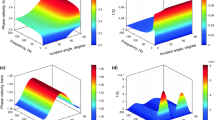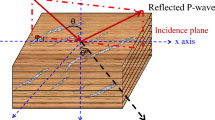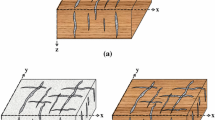Abstract
The theory of frequency-dependent amplitude versus offset (AVO) was developed for patchy-saturated model. In this work, we consider this theory in the case of an anisotropic medium based on a fractured-sandstone model. Thus, building on viscoelastic theory, we introduce a method for the computation of frequency-dependent AVO that is suitable for use in the case of an anisotropic medium. We use both analytical methods and numerical simulations to study P-P and P-S reflection coefficients, and results suggest that dispersion and anisotropy should not be neglected in AVO analysis. Indeed, for class I AVO reservoirs, the reflection magnitude of P-wave increases with frequency, while the responses of class II AVO reservoirs suggest that phase reversal occurs as frequency increases positively. In the case of class III AVO reservoirs, reflection magnitude decreases as frequency increases positively, while in the offset domain, the presence of anisotropy can distort or even reverse AVO responses. Thus, when compared to reflection coefficients for P-wave, reflection magnitude features of S-wave are more complex. The frequency-dependent AVO responses reported in this study provide insights for the interpretation of seismic anomalies in vertical transverse isotropy (VTI) dispersive reservoirs.












Similar content being viewed by others
References
Brajanovski, M., & Müller, T.M. (2007). Strong dispersion and attenuation of P-waves in a partially saturated fractured reservoir: 77th Annual internal meeting, SEG Expanded Abstracts, pp. 1407–1410.
Brajanovski, M., B. Gurevich, & G. Lambert. (2003). Attenuation and dispersion of compressional waves in porous rocks with aligned fractures: 73rd Annual internal meeting, SEG Expanded Abstracts, pp. 1620–1623.
Brajanovski, M., Gurevich, B., & Schoenberg, M. (2005). A model for P-wave attenuation and dispersion in a porous medium permeated by aligned fractures. Geophysical Journal International, 163(1), 372–384.
Carcione, J. M. (1997). Reflection and transmission of qP-qS plane waves at a plane boundary between viscoelastic transversely isotropic media. Geophysical Journal International, 129(3), 669–680.
Carcione, J.M. (2007). Wave fields in real media: Wave propagation in anisotropic, anelastic, porous and electromagnetic media, Handbook of Geophysical Exploration: Seismic Exploration, vol. 38: Elsevier Science (2nd revised edition).
Carcione, J. M., Gurevich, B., & Cavallini, F. (2000). A generalized Biot-Gassman model for the acoustic properties of shaley sandstones. Geophysical Prospecting, 48(3), 539–557.
Carcione, J. M., Gurevich, B., Santos, J. E., & Picotti, S. (2013). Angular and frequency-dependent wave velocity and attenuation in fractured porous media. Pure and Applied Geophysics, 170(11), 1673–1683.
Gurevich, B., Brajanovski, M., Galvin, R. J., Müller, T. M., & Toms-Stewart, J. (2009). P-wave dispersion and attenuation in fractured and porous reservoirs—poroelasticity approach. Geophysical Prospecting, 57(2), 225–237.
Gurevich, B., Zyrianov, V. B., & Lopatnikov, S. L. (1997). Seismic attenuation in finely layered porous rocks: effects of fluid flow and scattering. Geophysics, 62(1), 319–324.
Krief, M., Garat, J., Stellingwerff, J., & Ventre, J. (1990). A petrophysical interptretation using the velocities of P and S waves (full-waveform sonic). The Log Analyst, 31(6), 355–369.
Krzikalla, F., & Müller, T.M. (2011). Anisotropic P-SV-wave dispersion and attenuation due to inter-layer flow in thinly layered porous rocks: Geophysics, 76(3), WA135–WA145.
Lambert, G., Gurevich, B., Brajanovski, M. (2004). Numerical modeling of attenuation and dispersion of P-waves in porous rocks with planar fractures: 74th Annual internal meeting, SEG Expanded Abstracts, pp. 169–1693.
Lambert, G., Gurevich, B., & Brajanovski, M. (2006). Attenuation and dispersion of P-waves in porous rocks with planar fractures: comparison of theory and numerical simulations. Geophysics, 71(3), N41–N45.
Liu, L., Cao, S., & Wang, L. (2011). Poroelastic analysis of frequency-dependent amplitude-versus-offset variations. Geophysics, 76(3), C31–C40.
Nelson, R.A. (2001). Geological analysis of naturally fractured reservoirs, 2nd ed.: GulfPubl. Co.
Norris, A. N. (1993). Low-frequency dispersion and attenuation in partially saturated rocks. Journal of the Acoustical Society of America, 94(1), 359–370.
Pride, S. R., Berryman, J. G., & Harris, J. M. (2004). seismic attenuation due to wave-induced flow. Journal of Geophysical Research, 109(1), B1201.
Ren, H., Goloshubin, G., & Hilterman, F. J. (2009). Poroelastic analysis of amplitude-versus-frequency variations. Geophysics, 74(6), N41–N48.
Rüger, A. (1997). P-wave reflection coefficients for transversely isotropic models with vertical and horizontal axis of symmetry. Geophysics, 62(3), 713–722.
Rüger, A. (1998). Variation of P-wave reflectivity with offset and azimuth in anisotropic media. Geophysics, 63(3), 935–947.
Schmidt, H., 2011, OASES Version 3.1 User Guided Reference Manual: Department of Ocean Engineering Massachusetts Institute of Technology.
Schmidt, H., & Tango, G. (1986). Efficient global matrix approach to the computation of synthetic seismograms. Geophysical Journal International, 84(2), 331–359.
White, J. E. (1975). Computed seismic speeds and attenuation in rocks with partial gas saturation. Geophysics, 40(2), 224–232.
White, J. E., Mikhaylova, N. G., & Lyakhovitskiy, F. M. (1975). Low-frequency seismic waves in fluid-saturated layered rocks: Izvestijia Academy of Sciences USSR. Physics of the Solid Earth, 11(10), 654–659.
Acknowledgements
This work is kindly supported by the National Science and Technology Major Project of China (Grant No. 2011ZX05024-001-01), National Nature Science Foundation Project of China (Grant No. 41674128), and Sinopec Geophysical Research Institute. We are also grateful to the Department of Ocean Engineering of the Massachusetts Institute of Technology for permission to use the OASES software. We thank two anonymous reviewers and the editor-in-chief for useful comments.
Author information
Authors and Affiliations
Corresponding author
Appendices
Appendix A
1.1 Elastic moduli for low and high-frequency limits
In Eq. 1, low-frequency limit (relaxed) stiffnesses are as follows:
Besides that, the high-frequency limited (unrelaxed) stiffnesses in Eq. 1 are given as follows:
Here
The normalized frequency in Eq. 2 is as follows:
Appendix B
2.1 Empirical model for elastic modulus
On the basis of the empirical model presented by Krief et al. (1990), dry-rock bulk and shear modulus can be computed as follows:
Rock permeability, \(\kappa_{b}\), is computed using the equation derived by Carcione et al. (2000), as follows:
where \(r_{\text{s}} = 20\) μm denotes average grain radius.
Appendix C
3.1 Slowness in VTI media
Horizontal slowness \(s_{x}\) in VTI media is defined as follows:
In this expression, \(\theta\) is the angle of incidence, while \(V(\theta )\) is the phase velocity of a qP-wave, given by Eq. 3.
Vertical slowness \({\text{s}}_{z}\) is expressed as follows:
In Eq. 35, as follows:
and
In this expression, \(p_{11}\), \(p_{13}\), \(p_{33}\), \(p_{55}\) are given by Eq. 1, and the signs in \(s_{z}\) correspond to:
(+, −) downward qP-wave;
(+, +) downward qS-wave;
(−, −) upward qP-wave, and;
(−, +) upward qS-wave.
Rights and permissions
About this article
Cite this article
Yang, X., Cao, S., Guo, Q. et al. Frequency-Dependent Amplitude Versus Offset Variations in Porous Rocks with Aligned Fractures. Pure Appl. Geophys. 174, 1043–1059 (2017). https://doi.org/10.1007/s00024-016-1423-8
Received:
Revised:
Accepted:
Published:
Issue Date:
DOI: https://doi.org/10.1007/s00024-016-1423-8




